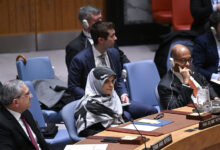
The pouring of arms into Ukraine and European rearmament plans benefit weapons makers but also pose risks, a watchdog told Sky News

FILE PHOTO. Defence manufacturer Raytheon exhibition at the Farnborough Air Show. ©In Pictures Ltd. / Corbis via Getty Images
The sharp increase in military spending by Western countries, necessary to supply weapons to Ukraine and rearm their own militaries, is a boon to defense contractors, Sky News said on Friday.
But while the likes of Lockheed Martin and Boeing enjoy profits, the arms race poses a threat to European stability, the article said, citing data from the Stockholm International Peace Research Institute (SIPRI), a leading weapons watchdog. The British outlet spoke to Siemon Wezeman, a senior researcher at the arms transfers program of the SIPRI.
NATO countries have committed more than $8 billion worth of military equipment to Ukraine with the stated goal of helping the country defend itself against Russia. More than half of the sum came from the US alone. The US Congress has already approved future defense spending related to arming Ukraine and replenishing American weapons stockpiles depleted by the aid.
American defense contractors are the ones benefiting most from the spending spree. Raytheon and Lockheed Martin will be producing replacements for the thousands of Javelin anti-tank rockets sent to Ukraine by the US and its allies. Raytheon is also the producer of the Stinger anti-aircraft missile, another popular item on the Ukraine aid lists. Lockheed Martin makes the HIMARS multiple rocket launchers, which Washington approved for sending to Ukraine in its latest package.


Read more
Northrop Grumman produces the anti-artillery radar systems that the US supplies to Ukraine. AeroVironment is the producer of the Switchblade anti-tank loitering munitions, often dubbed ‘kamikaze drones’ by the press. And Olin, America’s largest small-arms ammo producer, will likely benefit from the billions of rounds sent to Ukraine, Sky News pointed out.
In Europe, BAE Systems and Thales are among the big winners from the Ukraine-arming spree. BAE makes ammo and artillery shells, as well as MILAN anti-tank missiles, which France and Italy sent to Ukraine. It also makes Stormer HVM armored vehicles, which the UK provided to Kiev.
Thales produces the NLAW shoulder-launched anti-tank missiles and the Starstreak anti-aircraft missiles, which Stormer armored vehicles carry as their primary air-defense weapons. The German firm Dynamit Nobel makes the man-portable anti-tank weapon systems Panzerfaust 3 and MATADOR.
The billions in military aid are dwarfed by the hundreds of billions that European NATO members have pledged to beef up their own militaries. Germany alone seeks to invest €100 billion ($105 billion) into its military, while pledges made by 14 other European nations add up to the same amount, according to the report. Companies such as the German armor producer Rheinmetall, as well as Lockheed Martin, the American maker of F35 fighter jets, will also partake in the windfall from this.


Read more
The military procurements may come with downsides, however. Weapons sent to Ukraine “may end up disappearing into the black market,” the SIPRI’s Wezeman warned. As for the European rearmament program, questions could arise about whether it is money well spent, especially given that these funds will have to be taken from other things. The combined military spending of NATO members in Europe has exceeded Russia’s outlays since the end of the Cold War, he pointed out.
“Is Russia really the threat that we make it out, that you need to spend an enormous amount of money in addition to what you already spend?” Wezeman wondered.
“It seems to be a little bit of a shock reaction. You get attacked, you kick, and the kick in this case is you just throw in lots of military spending, and big plans for new tanks and new that, but is that really necessary?” he explained.
Then there is also the Russian reaction to the increase of the NATO military strength in Europe. Facing an overwhelming conventional force, Moscow may counter it by fielding more tactical nuclear weapons, the report suggested. NATO took a similar approach during the Cold War, when it was concerned by the number of tanks possessed by the Warsaw Pact nations, Wezeman noted.




